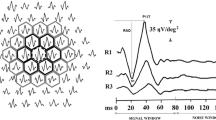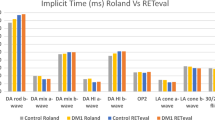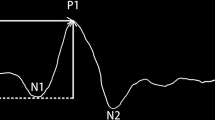Abstract
The purpose of this study was to investigate the early alterations of retinal function, assessed with electrophysiology, in newly onset type 2 diabetes patients without vascular retinopathy. Seventeen patients with newly diagnosed type 2 diabetes (duration 7 ± 3 months), without any vascular retinopathy in fundus photographs, were examined with full-field electroretinogram (ERG) and multifocal ERG (mfERG). The results were compared with those of age-matched subjects without diabetes. In the dark-adapted full-field ERG, the a-wave and the 30-Hz flicker implicit times were delayed in diabetes patients compared to controls, P = 0.001 and P = 0.020. In the first-order kernel of the mfERG, the first positive wave, P1, was delayed in all areas measured. The electrophysiological examinations demonstrate early alterations of retinal function characterised by a delayed a-wave implicit time in the dark-adapted full-field ERG, representing the rod signalling, and alterations in the multifocal ERG reflecting cone and/or postreceptoral function.



Similar content being viewed by others
References
Shaw JE, Sicree RA, Zimmet PZ (2030) Global estimates of the prevalence of diabetes for 2010 and 2030. Diabetes Res Clin Pract 87(1):4–14
Trautner C, Icks A, Haastert B, Plum F, Berger M (1997) Incidence of blindness in relation to diabetes. A population-based study. Diabetes Care 20(7):1147–1153
Antonetti DA, Barber AJ, Bronson SK, Freeman WM, Gardner TW, Jefferson LS, Kester M, Kimball SR, Krady JK, LaNoue KF, Norbury CC, Quinn PG, Sandirasegarane L (2006) Diabetic retinopathy: seeing beyond glucose-induced microvascular disease. Diabetes 55(9):2401–2411
Juen S, Kieselbach GF (1990) Electrophysiological changes in juvenile diabetics without retinopathy. Arch Ophthalmol 108(3):372–375
Palmowski AM, Sutter EE, Bearse MA Jr, Fung W (1997) Mapping of retinal function in diabetic retinopathy using the multifocal electroretinogram. Invest Ophthalmol Vis Sci 38(12):2586–2596
UK Prospective Diabetes Study (1990) Complications in newly diagnosed type 2 diabetic patients and their association with different clinical and biochemical risk factors. Diabetes Res 13(1):1–11
Hoelzel W, Weykamp C, Jeppsson JO, Miedema K, Barr JR, Goodall I, Hoshino T, John WG, Kobold U, Little R, Mosca A, Mauri P, Paron R, Susanto F, Takei I, Thienpont L, Umemoto M, Wiedmeyer HM (2004) IFCC reference system for measurement of hemoglobin A1c in human blood and the national standardization schemes in the United States, Japan, and Sweden: a method-comparison study. Clin Chem 50(1):166–174
Marmor MF, Fulton AB, Holder GE, Miyake Y, Brigell M, Bach M (2009) ISCEV Standard for full-field clinical electroretinography (2008 update). Doc Ophthalmol 118(1):69–77
Holfort SK, Klemp K, Kofoed PK, Sander B, Larsen M (2010) Scotopic electrophysiology of the retina during transient hyperglycemia in type 2 diabetes. Invest Ophthalmol Vis Sci 51(5):2790–2794
Hood DC, Bach M, Brigell M, Keating D, Kondo M, Lyons JS, Palmowski-Wolfe AM (2008) ISCEV guidelines for clinical multifocal electroretinography (2007 edition). Doc Ophthalmol 116(1):1–11
Jamison JA, Bush RA, Lei B, Sieving PA (2001) Characterization of the rod photoresponse isolated from the dark-adapted primate ERG. Vis Neurosci 18(3):445–455
Robson JG, Saszik SM, Ahmed J, Frishman LJ (2003) Rod and cone contributions to the a-wave of the electroretinogram of the macaque. J Physiol 547(Pt 2):509–530
Bresnick GH, Palta M (1987) Temporal aspects of the electroretinogram in diabetic retinopathy. Arch Ophthalmol 105(5):660–664
Kim SH, Lee SH, Bae JY, Cho JH, Kang YS (1997) Electroretinographic evaluation in adult diabetics. Doc Ophthalmol 94(3):201–213
Luu CD, Szental JA, Lee SY, Lavanya R, Wong TY (2010) Correlation between retinal oscillatory potentials and retinal vascular caliber in type 2 diabetes. Invest Ophthalmol Vis Sci 51(1):482–486
Wangsa-Wirawan ND, Linsenmeier RA (2003) Retinal oxygen: fundamental and clinical aspects. Arch Ophthalmol 121(4):547–557
Tyrberg M, Ponjavic V, Lovestam-Adrian M (2008) Multifocal electroretinogram (mfERG) in patients with diabetes mellitus and an enlarged foveal avascular zone (FAZ). Doc Ophthalmol 117(3):185–189
Han Y, Bearse MA Jr, Schneck ME, Barez S, Jacobsen CH, Adams AJ (2004) Multifocal electroretinogram delays predict sites of subsequent diabetic retinopathy. Invest Ophthalmol Vis Sci 45(3):948–954
Bronson-Castain KW, Bearse MA Jr, Neuville J, Jonasdottir S, King-Hooper B, Barez S, Schneck ME, Adams AJ (2009) Adolescents with type 2 diabetes: early indications of focal retinal neuropathy, retinal thinning, and venular dilation. Retina 29(5):618–626
Klemp K, Larsen M, Sander B, Vaag A, Brockhoff PB, Lund-Andersen H (2004) Effect of short-term hyperglycemia on multifocal electroretinogram in diabetic patients without retinopathy. Invest Ophthalmol Vis Sci 45(10):3812–3819
Kohner EM, Patel V, Rassam SM (1995) Role of blood flow and impaired autoregulation in the pathogenesis of diabetic retinopathy. Diabetes 44(6):603–607
Grunwald JE, DuPont J, Riva CE (1996) Retinal haemodynamics in patients with early diabetes mellitus. Br J Ophthalmol 80(4):327–331
Tyrberg M, Ponjavic V, Lovestam-Adrian M (2005) Multifocal electroretinography (mfERG) in insulin dependent diabetics with and without clinically apparent retinopathy. Doc Ophthalmol 110(2–3):137–143
Sutter EE, Bearse MA Jr (1999) The optic nerve head component of the human ERG. Vis Res 39(3):419–436
Acknowledgments
This study was supported by the Gorthon and Zoéga Foundations, the Committee for the Blind in Malmohus County, the Gyllenstierna Krapperup′s Foundation, the Swedish Medical Research Council and the Skane County Council′s Research and Development Foundation. The authors are grateful to Eva Steffert and Birgitta Teinvall for photographing and grading, and to Boel Nilsson and Ing Marie Holst for help with electrophysiological examinations.
Conflict of interest
None.
Author information
Authors and Affiliations
Corresponding author
Rights and permissions
About this article
Cite this article
Tyrberg, M., Lindblad, U., Melander, A. et al. Electrophysiological studies in newly onset type 2 diabetes without visible vascular retinopathy. Doc Ophthalmol 123, 193–198 (2011). https://doi.org/10.1007/s10633-011-9298-6
Received:
Accepted:
Published:
Issue Date:
DOI: https://doi.org/10.1007/s10633-011-9298-6




